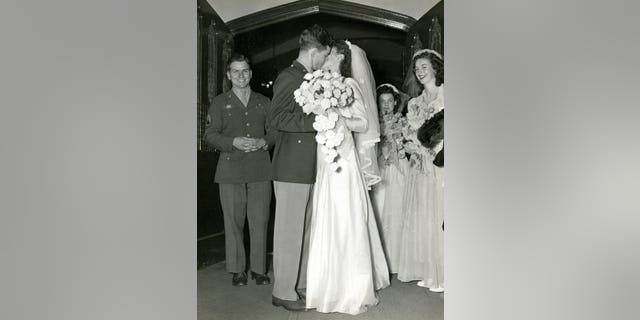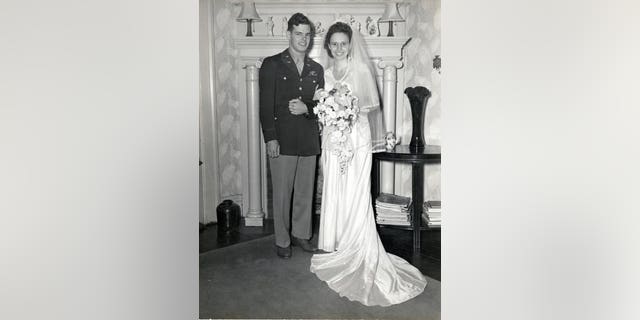Valentine's Day memory – my mother wore a WW2 parachute wedding dress

World War II veterans recount 75 years since VJ Day
Veterans recall the joy of returning home after Japan’s surrender.
On the evening of March 26, 1943, my dad was a lonely Army private who attended a church service in an unadorned chapel in Buffalo, New York. It was a Friday night, and most of his fellow aviation students were out on the town blowing off steam. He had opted to attend this religious retreat instead.
Charles and Mary Alice Stanley, their newlyweds’ first dance on their wedding day, Oct. 27, 1945.
A trio of girls, students from the local teachers’ college, sat above in the choir loft surveying the male contingent below. Per custom, the soldiers had removed their Army caps. One head of wavy black hair stood out. Lorraine, a pretty blond, pointed at him. “Did you see the cute one?”
“I don’t like cute boys!” snapped Mary Alice Schmitz.
She had indeed noticed the handsome private at the registration table, but boys with his kind of looks never seemed interested in bespectacled, serious girls like her. Besides, she volunteered regularly at the local USO and knew how visiting soldiers could be.
When the weekend retreat continued the next day, the program’s moderator asked Mary Alice to take a count for the Sunday communion breakfast. Approaching a lone soldier, she realized that he was the “cute one” from the evening before. The soldier told her his name, Charles Stanley, and that he would attend.
“What a pretty girl,” my dad thought. Her glasses didn’t bother him a bit.
Charles and Mary Alice Stanley, kissing outside the church after their wedding ceremony.
When the weekend retreat continued the next day, the program’s moderator asked Mary Alice to take a count for the Sunday communion breakfast. Approaching a lone soldier, she realized that he was the “cute one” from the evening before. The soldier told her his name, Charles Stanley, and that he would attend.
“What a pretty girl,” my dad thought. Her glasses didn’t bother him a bit.
It happened that the fellow student who was giving him a ride back to his barracks across town was a neighbor of Mary Alice’s. When it was time to leave, they all climbed into the same car. Soon dad was seeing Mary Alice at every chance.
Two months later, he moved on to another training site and became a bomber pilot, but he and Mary Alice continued their romance via an extraordinary correspondence that lasted until the end of the war.
The bride and groom, Oct. 27, 1945. Charles carried his parachute across Yugoslavia so Mary Alice could use it as material for her wedding dress.
Their letters were interrupted twice. The first time, dad and his crew bailed out over Romania but returned in just over a week. The second time, they bailed out over Yugoslavia. He was picked up by the Partisan underground but remained missing for two months. His adventures in Yugoslavia would become the basis of my upcoming book, “Lost Airmen.”
Dad carried his parachute all the way across Yugoslavia so that Mary Alice, my mother, could use it as material for her wedding dress. He later claimed that she was disappointed he didn’t bring the parachute back the first time he was shot down, so he had to bail out again a second time to get another one.
They married on Oct. 27, 1945. The story of the parachute wedding dress was picked up by news wire services and was published in newspapers all over the Northeast. My parents were married for 30 years, and had five children, 13 grandchildren, and 10 great-grandchildren.
Source: Read Full Article




